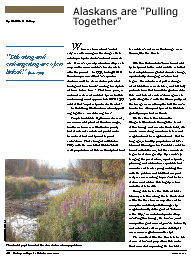|
Invasive Species Invasive species are infiltrators that invade and cause harm to ecosystems beyond their historic range. Their invasion can threaten native ecosystems or commercial, agricultural, or recreational activities dependent on these ecosystems. They may even harm the health of humans. Human actions, both unintentional and intentional, are the primary means of invasive species introductions and spread to new locations. The U.S. Fish and Wildlife Service (Service) works with federal and state agencies and private groups to implement national, regional and local-level invasive species management activities and share information and new techniques for fighting invasive species. Prevention, early detection, rapid response, and control and management are key components of the National Invasive Species Management Plan and interagency/interdepartmental programs. Communications, education, and research are integral to those key components. For additional information, please visit the following websites: The Service's Aquatic Nuisance Species (ANS) web site has a lot of valuable information about ANS, including who to contact to report a species or ask a question, Service ANS activities, and laws and regulations related to ANS. The Service's Injurious Wildlife web page provides a current list of injurious wildlife species and information on species under evaluation and the Lacey Act. The Aquatic Nuisance Species (ANS) Task Force is an intergovernmental organization dedicated to preventing and controlling aquatic nuisance species, and implementing the Nonindigenous Aquatic Nuisance Prevention and Control Act (NANPCA) of 1990 and the reauthorization of the 1996 National Invasive Species Act. The "Stop Aquatic Hitchhikers!" National Public Awareness Campaign and website encourages recreational users to become part of the solution in stopping the transport and spread of these harmful invasive species. The Habitattitude™ National Public Awareness Campaign and website encourages aquarium hobbyists, backyard pond owners, water gardeners and others who are concerned about aquatic resource conservation to properly dispose of unwanted plants and animals while promoting responsible consumer behaviors. The 100th Meridian Initiative is a cooperative effort between state, provincial, and federal agencies to prevent the westward spread of zebra mussels and other aquatic nuisance species in North America. The National Invasive Species Council (NISC), created by Executive Order 13112 February 3, 1999, is an inter-Departmental council, co-chaired by the secretaries of the Agriculture, Commerce, and Interior, that helps to coordinate and ensure cost-efficient and effective Federal activities regarding terrestrial and aquatic invasive species. The Federal Interagency Committee for the Management of Noxious and Exotic Weeds (FICMNEW), is a partnership between 16 federal agencies with direct invasive plant management and regulatory responsibilities spanning across the United States and its territories. The U.S. Department of Agriculture's website for the National Invasive Species Information Center serves as a gateway to invasive species information by covering federal, state, local and international sources. The National Biological Information Infrastructure (NBII). Invasive Species Information Node. | |||||||||
| Last Updated: September 24, 2008 | ||||||||||


